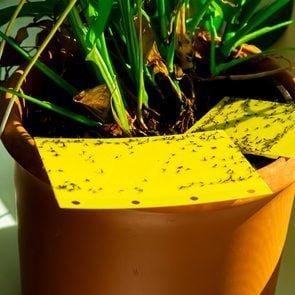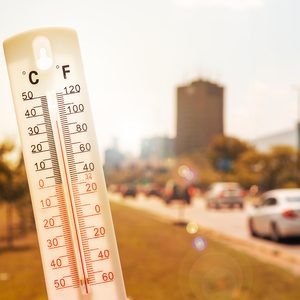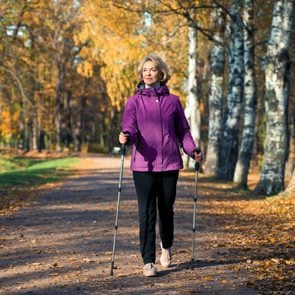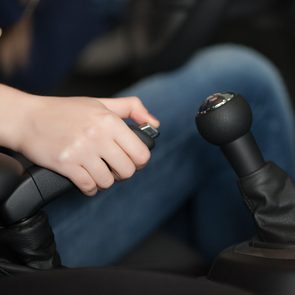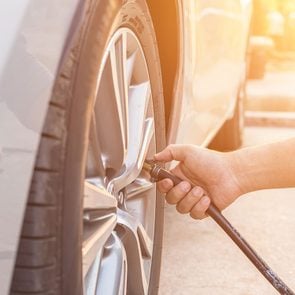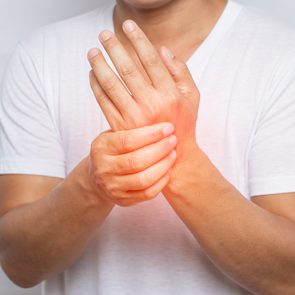A 2021 study from Singapore found that people who do housework are fitter than those who don’t. Tackling “high intensity” tasks such as cleaning windows helps improve physical health and mental faculties, especially among the elderly.
The mental aspect doesn’t surprise me. Attempting to change my duvet cover often leaves me entirely submerged in the thing, my hands holding its corners inside the cover, wondering what to do next. I’m pretty sure the widespread belief in ghosts stems from people becoming permanently entangled in their duvet covers.
Stacking the dishwasher is worse, with a hundred possible solutions to the problem of fitting everything in, only one of which is judged as correct by other household members. Has a dishwasher ever been stacked without someone saying: “Not that way, you’ve got it all wrong!”?
The bathroom leads to more disputes. It’s my belief that every time you have a shower, the shower has a shower and is therefore self-cleaning. But my wife, Jocasta, believes the shower recess needs to be cleaned separately, a task I achieve by stripping naked and attacking it on my knees with a scrubbing brush, my backside waggling from side to side as I work away at the grime.
Jocasta enjoys the sparkling results but remains uncertain about whether it’s worth the flashbacks. Apparently, there are some things that, once seen, cannot be unseen.
As for cleaning windows, it’s impossible to achieve a good result. I work hard at it, spraying on the fluid and scrubbing the glass with a crumpled sheet of newsprint. Everything looks spotless until the sun hits the windows the next morning, upon which they resemble a Jackson Pollock painting.
I then wash them again, which only moves the swirls from one place to another. Maybe I’m using the wrong section of the newspaper.
Next in my housework/workout regimen, I sweep up, which creates a pile of dog hair so unfeasibly large that I wonder if there’s anything left of the dog. Maybe I could sell his hair for wigs and turn a profit.
The late British writer and eccentric Quentin Crisp famously claimed that if you don’t do housework, dirt will stop accumulating after four years. I don’t know if this is entirely true. I have memories of student houses in which the type of flooring was uncertain, so complete was the coverage of motorcycle parts, pizza boxes and general filth. I remember the moment someone moved a pizza box and exclaimed: “Hey, there’s a carpet under here!” Nature abhors a vacuum and so did these young men. Was it a coincidence that they were all out of shape? I think not. The bathroom was worse. Every time I hazarded a visit, I remember optimistically wondering if “Putrid Black” was just another colour in the range of bathroom fittings.
I hope my housemates eventually realized one of life’s great truths: Romantic partners find people who perform their share of the housework more arousing. Jocasta’s erogenous zones, I’ve learned, include the kitchen floor, the bathroom and the lint filter in the clothes dryer.
What other housework can we throw ourselves into and make ourselves fitter at the same time? I have found that organizing the Tupperware drawer is a good start, as it tends to involve a lot of crouching, standing and then crouching again. There’s also the moral and intellectual tussle of whether to throw out the lids that have no bottoms and the bottoms that have no lids, or wait to see if missing parts turn up.
And by never having the lawn mower serviced, I have cleverly created a system in which starting it involves two hours of sweat-inducing cord-pulling.
That’s the thing about housework. As the Singaporeans discovered, you’ve got to use your body and your brains.
Next, check out 13 cleaning hacks that take the hassle out of housekeeping.
You’ve tried everything: Bug spray, citronella candles, bug repellent bracelets. You’ve planted mosquito-repelling plants, like rosemary, basil and marigolds. Yet despite how many different hacks you’ve tried, nothing seems to ward off the mosquitoes that attack when the sun sets below the horizon.
After so many attempts at trying to get rid of those pesky bugs, just hoping you can finally enjoy a night outside in peace, you may start wondering if there’s something else that’s making you a mosquito magnet. Do mosquitoes really gravitate toward certain blood types? Or could it really be as simple as how you smell?
Turns out, according to a recent study from researchers in the College of Agriculture and Life Sciences at Virginia Tech, your smell can actually attract or repel those summertime pests—particularly the scent of your soap. These researchers found that soaps with the scent of plants and florals can unfortunately attract mosquitoes. That soothing rose body wash or that lavender-scented bar soap you love? They could be to blame for all of those bug bites you find yourself scratching at the end of the day.
For more wellness updates, sign up for the (free!) Reader’s Digest Health Report.
What the study says
Chloé Lahondère, Ph.D., a study author and assistant professor of biochemistry at Virginia Tech who focuses on research regarding Mechanisms of Thermal Adaption in Insects, explains that the purpose of this study was to determine which chemicals and scents humans add to their original body odour would attract mosquitoes.
“We expected that adding these chemicals to our body odour would affect their attraction, in one way or another,” Lahondere says. “But what was surprising in our results was the importance of the interaction between the specific soap chemicals and the body odour of each specific individual in determining whether a person would become more or less attractive to mosquitoes after applying soap to their skin. In other words, we were surprised to see that some soaps, but not others, would increase the attractiveness of some people.”
“Three out of four soaps we tested in this preliminary study increased mosquito attraction for our volunteers,” says Clément Vinauger, Ph.D., another author of the study who also works as an assistant professor of biochemistry at Virginia Tech and specializes in Molecular Genetics of Host-Seeking Behaviour in Insects. “These soaps have in common that they are rich in terpenes, a class of chemicals typically produced by plants and found in the scent of flowers and fruits. Among them, we found allyl heptanoate, which is naturally found in the scent of tropical fruits and used in perfumery to imitate the pineapple scent, was often associated with increased mosquito attraction.”
In particular, floral scents tend to attract mosquitoes given that these bugs use plant-emitted volatiles to find these types of plants to obtain the sugars from the nectar. With soap that smells like these attractive florals, it makes sense that mosquitos would be attracted to similar-smelling skin.
However, Vinauger does point out that it is the combination of the scent and a person’s natural body odour that can attract bugs, so certain soaps may work for some and not others. For those who find themselves constantly attacked by mosquitoes, it may be a trial and error process to find the right soap that works for you.
Look for particular chemicals in your soap
The results of the study not only point out specific scents that may attract mosquitoes, but also points out how personal care products contain certain chemicals that can increase mosquito activity due to these scents. Lahondere says this information could be critical for the hygiene industry.
“We should definitely be looking more carefully at the composition of the personal care products we use,” Lahondere continues. “As stated in the study, the same soap used by different people can have different effects on mosquito behaviour. However, it might be better to stay away from personal care products that contain high levels of chemicals that mosquitoes are known to be attracted to, like linalool.”
Linalool is a popular floral chemical found in over 200 different flowers and plants—like lavender and citrus fruits—and is used in 60% to 80% of perfumed hygienic products such as soaps, lotions, detergents and shampoos. Previous studies have actually made a connection between linalool repelling female mosquitoes, sometimes more so than citronella, which is a scent commonly used in candles and bug repellents. However, with this study indicating otherwise, products that use this chemical may not have the repelling effect we once believed.
“We can provide critical information to the industry to develop new personal care products that do not contain mosquito attractants—or if they do, highlighting that a specific ratio of these compounds should be used so the soap or perfume does not increase mosquito attraction (and thus biting),” she says.
The best soap fragrance for fighting mosquitoes
If floral-scented soaps aren’t helping with fighting off mosquitoes, then what will? According to previous research, it may be wise to swap out your go-to soap product with something that is coconut scented or based.
“Multiple publications—including ours—have shown that coconut-derived chemicals tend to have a repellent effect on blood-feeding insects,” says Lahondere. “To our knowledge, the underlying mechanisms remain unclear.”
One 2018 study from the U.S. Department of Agriculture even found coconut oil to be a better bug-repellent than DEET—a chemical used in popular bug-repellent products. The study found the coconut oil fatty acids had a strong repellency and long-lasting effectiveness (95% effective compared to DEET, which was only at 50% during the study) to ward off pesky bugs including mosquitoes, ticks, biting flies and bed bugs.
While more research needs to be done, if you had to choose a scented soap to use this summer, a natural coconut-based soap (with fewer chemicals) would give you more of a fighting chance against irksome mosquito bites compared to your usual floral-scented body wash.
Next, find out the most harmful ingredients in your beauty products.
When summer is in full swing and it’s time to switch on the air conditioning, you may find yourself in one of two camps: Complaining the thermostat setting is too cold, or uncomfortably warm because someone set it too high.
No one likes sweating while they’re relaxing in their home, just as no one likes to wear a woolly sweater in July. Let’s take a look at the ideal temperature to set your thermostat in the summer, keeping everyone comfortable while preventing your energy bill from going through the roof.
Ideal Thermostat Setting for Summer
Just as 20 C (68 F) is considered the ideal winter thermostat setting, experts call 25 C (78 F) the magic number for the summer months. This interior temperature should be amenable to most members of your household.
According to energy provider Direct Energy, even if family members need a little time to adjust to it, 25 C (78 F) hits the sweet spot between keeping everyone cool and containing your energy bill.
As an additional money-saving step, some sources recommend leaving the thermostat between 26 and 28 C (80 and 82 F) at night when everyone is asleep. Our body temperature drops as we sleep, so theoretically we can tolerate higher temperatures. Lightweight or minimal sleepwear, plus sleeping with just a sheet, can help.
Natural Resources Canada recommends combining fans and air conditioners to save on your electricity bill, and give your system a break. Direct Energy recommends setting it as high as 31 C (88 F) when no one is home, especially if you leave on vacation and take your pets with you.
But if you have pets in the home, keep in mind birds and many small mammals can’t tolerate indoor temperatures higher than 29 C (85 F). Dogs shouldn’t be in indoor temps higher than 27 C (82 F).

Adjusting Your Internal Thermostat
Seventy-eight degrees may be the best thermostat setting for your energy bill, but it may feel uncomfortably warm to some people. Mitigating factors include the location of the home, how much direct sunlight the house gets and how well insulated it is. If you or other members of your household feel 25 C (78 F) is still too high, here are some tips for staying cool:
- Wear lightweight, loose-fitting clothing.
- Use ceiling fans when you’re in the room.
- Avoid using the oven during the day.
- Take a cool shower before bedtime.
If none of that works, try lowering the thermostat by one degree each day until everyone finds the most comfortable temperature.
Don’t miss these pro tips on how to stay cool in extreme heat.
Does Thermostat Placement Affect Cooling?
Whatever the outdoor temperature, thermostat placement affects how your heating and cooling system performs. A thermostat placed in the wrong part of the home will give an inaccurate reading, also known as a “ghost reading.” While this is more of a problem in the winter, it can be an issue in the summer, too.
If a thermostat is in a hotter area of the home, it will keep asking the air conditioner to pump cool air even if the rest of the home is already cooled to 25 C (78 F) or lower. Try to avoid the following locations for a thermostat:
- Areas in direct sunlight, which will give a falsely high reading
- Directly above air vents, which will give a falsely low reading
- Kitchens, which tend to be sunnier, warmer rooms and may give a falsely high reading
- Near doors or windows, where sunlight and ambient heat may create a falsely high reading
Don’t worry about running a ceiling fan in the same room as the thermostat. Fans cool people, not air, and won’t affect the thermostat reading.
How Can You Get More Out of Your Thermostat?
To maximize home comfort and energy savings, it might be time for a thermostat upgrade. Consider one of these options, especially if you want to adjust interior temperatures depending on time of day and occupancy.
- Smart thermostats connect to your home’s WiFi system and self-adjust based on a programmed schedule or the daily weather. Many allow you to place motion sensors in each room so you only cool or heat a room when it’s occupied.
- Programmable thermostats typically function with an app so they can be controlled remotely, although simpler models require you to program the settings at the wall thermostat. They allow you to program indoor temperatures based on household usage. For example, you can set higher temperatures during the workweek when everyone is gone, and cooler temps on weekends.
- WiFi thermostats connect to your home’s wireless internet service and let you remotely check and change the temperature from an app on your smartphone or tablet.
Next, find out how to keep your house cool without AC.
Traditional wisdom suggests that when your body hurts, you should rest. But when it comes to arthritis, research shows that physical activity can actually help relieve arthritis pain, as well as stiffness and swelling in the joints. Choosing the right kinds of activities, however, is important. Here are five of the best exercises to relieve arthritis pain.
Water Activities to Relieve Arthritis Pain
Swimming and aqua aerobics are great examples of water-based activities that can help relieve arthritis pain. The warm water of a heated pool makes moving easy and allows you to focus on range of motion in a slow, controlled and safe manner. The resistance that the water provides is also great for building muscle.
Tai Chi
Tai chi involves changing posture through a series of slow and controlled movements. This gentle exercise places very little stress on major joints like knees and ankles, and essentially makes movement easier by improving synovial fluid absorption in joint cartilage—effectively “lubricating” joints. The regular practice of tai chi has been linked to decreases in fatigue and joint pain as well as improved balance.
Yoga
Yoga is an ideal activity for arthritis sufferers, particularly because it helps improve both physical and psychological symptoms of the condition. In fact, regularly practicing yoga has been shown to relieve arthritis pain, improve joint flexibility and decrease stress and tension. Concerned you don’t have the flexibility required? Don’t be. Many yoga poses can be modified to make them accessible to beginners regardless of age or ability.
Brush up on the benefits of chair yoga for seniors.
Walking
Walking is a superb way to stay active without putting a strain on your joints. Once you’re comfortable walking at your own pace, challenge yourself to walk farther, faster or uphill. (Here’s what happens to your body when you start walking 10,000 steps a day.) Just keep in mind that introducing these greater degrees of difficulty will place added stress on your joints, so implement changes gradually. One of the best things about walking? If you need alone time, it’s a great opportunity to clear your mind. Alternatively, you can introduce a social aspect by inviting a walking buddy to join you. (Find out more ways to make walking less boring.)
Cycling
Many high-intensity activities are hard on your joints, but it’s still important for people with arthritis pain to get their hearts pumping each week. Cycling is a fantastic cardiovascular exercise because it can be done at a high intensity without placing any added pressure on your joints.
Now that you know the best exercises to relieve arthritis pain, find out if shark cartilage can really help with arthritis.

Why Gelato is Better Than Ice Cream
We all love ice cream, but gelato, sculpted into colourful waves or mountains behind glass counters the world over, is denser and its flavours more pronounced. Even better: Because it’s made with more milk and less cream, gelato is also lower in calories. In fact, apart from its fantastic taste, gelato is perhaps best characterized by the quality of its natural ingredients.
A History of Gelato
We think of frozen treats as modern marvels, but even people in ancient times enjoyed flavoured desserts made with naturally occurring ice. Egyptian pharaohs served their guests ice sweetened with fruit juice. Romans crushed ice from Mount Vesuvius and enjoyed it with honey. Many believe that the origin of gelato is a Chinese recipe Marco Polo brought back to Italy around the end of the 13th century. It called for milk and spices to be mixed with overcooked rice and snow.
Gelato’s Italian breakthrough came more than 200 years later, when astrologist Cosimo Ruggieri won a culinary contest sponsored by the influential Medici family with his fior di latte gelato, which omitted the rice. A smitten Catherine de Medici later had Ruggeri make it for her wedding to the future king of France.
However, Bernardo Buontalenti is considered to be the “father of gelato.” (An American gelato brand, Talenti, is named after him.) In 1565, the famous Florentine artist and architect created a new dessert based on zabaglione, a type of whipped custard. He used milk, egg yolks and honey flavoured with sweet wine, bergamot, lemon and orange for the court of Catherine de Medici.
Despite being a hit among royalty, gelato didn’t gain mass popularity in Europe until Le Procope, a Paris café owned by Francesco Procopio dei Coltelli, started serving it in 1686. (Procopio, a Sicilian, also created the first ice-cream making machine, which allowed for the large-scale production of the frozen dessert.)
The treat then came to America with Italian native Giovanni Basiolo, who arrived in New York City in 1770. Gelato didn’t become a sensation there, though, until the 1900s.
It’s Not Just For Dessert
Gelato can be enjoyed atop breakfast pastry (brioche con gelato) or drowned in a shot of espresso (affogato). You can even find savoury varieties such as red wine, olive oil or tomato with basil. Spun through the mind of a culinary wizard, it can be otherworldly: At Toronto’s Michelin-starred Don Alfonso 1890, an eel-infused version served on wild-rose tagliatelle with herbs and caviar is on offer.
Those who love it so much they want to become a true aficionado can attend Gelato University in Bologna, Italy, and learn how to create their own variations. GU also has a course for those with aspirations to be gelato shop owners; the school trains students on the details of how to make true gelato, and how to open and run a shop anywhere.
Most of us will be satisfied just enjoying the tasty stuff on a warm day. Dressed up with fruit, nuts or sprinkles, or served straight, gelato is truly one of the hottest commodities on the frozen-treat market.
Now that you’re craving a scoop of gelato, here are nine hydrating drinks—that aren’t water—to keep you refreshed all summer long.
If you live in a city, every commute could be a “best-of” reel of dangerous driving. Car doors, in particular, have become an excellent teaching aid in proving Newton’s law that no two objects can occupy the same space simultaneously. Bikers, often sandwiched in a bike lane between parked cars and flowing traffic, are so prone to being struck by errant car doors that the phenomenon has a name: dooring. Sadly, it’s more common than you’d think.
Back in 2011, there was roughly one dooring accident in Chicago every day of the year, accounting for about one in five of all reported bike crashes. New York City announced a plan to raise dooring awareness among taxi passengers by including a video advertisement and “LOOK! For Cyclists” sticker in all 13,000 city cabs (Chicago declined to pass a similar measure several years ago). This is a nice start for a city that serves about 336,000 cab passengers every day. Still, a sticker does not a behavioural overhaul make, and there are more than 250,000 daily Uber and Lyft passengers in the city who will miss this message altogether. What, then, is the next step to ensure peace between bikers and drivers?
The excellent urban design blog 99% Invisible reports a simple, almost effortless motion you can take as a driver or passenger of a motor vehicle concerned about cyclist safety: Just open your door with your right hand.
This tip comes to us from the Netherlands, which is why it’s known here as the “Dutch Reach.” If you are sitting on the driver’s side of a parked car and want to get out, don’t open the door with your door-side (left) hand as you’re intuitively prepared to—instead, open the door with your right hand. This simple motion causes you to pivot your entire upper body as you reach, first drawing your line of sight past by your rear-view mirror, and then out to the street behind you. (If you are on the passenger’s side, use your left hand instead of your right; the trick is just to use the hand furthest from the door to ensure an upper-body pivot.)
It’s just that simple—and it works. So effective is the Dutch Reach that it doesn’t even have a name in the bike-friendly Netherlands. For decades, that’s just how drivers have been taught to open a door.
Like any habit, the Dutch Reach will take a while to internalize. DutchReach.org, a safety advocacy movement trying to make the reach mainstream, has plenty of resources for spreading the word, and a few slogans that could help you remember. Our favourite: “Reach, Swivel, Look, Open.”
Of course, if it’s easier to remember, you could always just tell yourself to “Go Dutch.”
Next, check out these clever car gadgets that make driving safer.
When you notice your vehicle’s engine knocking (sometimes perceived as a pinging sound), take measures to address the problem immediately before your engine is damaged.
What Is Engine Knocking?
Pinging or knocking is audible evidence of premature combustion happening in one or more cylinders. It’s a major problem with expensive consequences if you ignore it.
A well-tuned engine depends on accurate timing to provide optimum power, efficiency and wear. The rotating crankshaft alternately drives the piston up through the cylinder and then is driven back by the force of the piston descending.
Simplified, the descending piston draws fuel and air into the cylinder, and then the ascending piston compresses the fuel/air mixture to optimize the power released at the point of ignition. This process happens repeatedly in each of the cylinders in your engine block. Due to careful engineering, each spark plug is energized as the crankshaft reaches a specific position in its rotation. Your vehicle’s timing manages the force of all the cylinders and keeps them pushing the crankshaft in the same direction.
Why Does Knocking Occur?
Knocking happens when the fuel in the cylinder ignites before it should. This premature ignition disrupts the smooth rotation of the engine by firing before the piston reaches top dead centre. The misfired piston then applies backward thrust to the crankshaft against the momentum of the engine, which causes the knock or ping that you hear, along with a slight hesitation that brings a loss of power. Knocking can damage the surface of the piston, the cylinder walls or the crankshaft bearings, all of which are expensive to repair.
Modern computer-controlled injection systems can correct your fuel mixture to prevent knocking, but at the cost of engine performance. In this case, loss of fuel efficiency tells you that the engine needs attention.
6 Conditions That Cause Engine Knocking
The six most common causes for engine knocking include:
- A fuel with a lower octane rating than the engine was designed to burn. Pressure has an effect on the flammability of fuel in a given environment. Lower octane fuel burns more readily under pressure, and thus can ignite spontaneously when subjected to too much pressure. (Here’s how to find the cheapest gas station near you.)
- Reduction of cylinder volume. Again, the dysfunction here relates to pressure. An accumulation of carbon occupies space in the cylinder, reducing its volume. Because the fuel/air mixture must compress into a smaller space, the pressure produced in the cylinder increases, creating the potential for premature ignition.
- Carbon buildups can retain heat, causing a “hot spot” that ignites the fuel prematurely. In this scenario, carbon buildup produces a double-whammy that not only steals cylinder volume, but also creates the spark needed to ignite the fuel directly.
- Improper spark plugs. Your vehicle’s engine requires a spark plug that matches its particular engineering tolerances. Installing the wrong spark plug will effect how hot the spark is, which can result in a knock.
- Disrupted fuel-to-air mixture. A poorly-functioning fuel injector may affect the mix of fuel and air entering the cylinder. This increases combustion chamber temperatures and can also change the dynamics of the gas mixture under pressure, creating the potential for premature ignition.
- Valve impingement. Moving parts near the top of the cylinder head must operate freely to properly regulate the flow of air, fuel and exhaust. Carbon build-up on the valve stems reduces air flow and, in severe cases, prevents the valve from closing, causing loss of compression.
How to Fix Engine Knocking
- The first step in trying to fix engine knocking is to upgrade to a gasoline with a higher octane rating. Higher-octane fuels can withstand more pressure before combustion. Switch to one that includes carbon-cleaning additives. This can prevent further buildup on the various parts in your vehicle’s engine that affect timing. In the short term, a bottle of carbon-cleaning additive can help scour the system and expedite resolution of causes 2, 3 and 5 above.
- Give your engine a tune-up that includes new spark plugs and wires.
- Regularly change the oil in your vehicle and monitor for a low oil level. Worn-out oil and low oil levels can contribute to poorly lubricated timing-related parts near the top of the engine.
Check out more strange car noises—and what they could mean.
My life from the teenage years onwards has always had a place for special vehicles, along with nature, agriculture and farming. While a high school student here in Lacombe, Alberta, I was involved in our local car club, The Road Hawks, which had two purposes: first, to restore and customize vehicles and second, to assist anyone needing help on the road. A “courtesy card” was always given to anyone we would help. Through this club, I became very good friends with the son of a much-respected General Motors dealership owner in Lacombe. Dave’s father was a huge collector of vintage cars, trucks and related memorabilia. After school, Dave and I would often head to his dad’s dealership to have a pop and do some janitorial work. On this one particular day—November 2, 1958—the dealership’s very first new 1959 model came into the showroom. It was a black-and-white fully loaded four-door hardtop, with rich red interior and a silver-fleck headliner. And those flat rear fins, wow! I fell in love with the car immediately and later tried to talk my mom and dad into buying it. Dad simply said, “Farmers don’t drive fancy cars like that.” End of conversation.
A local elderly retired couple bought the car and had put very few miles on it when the gentleman passed away several years after purchase. I did not want to bother the widow right away, but after a couple of months I dropped in, identified myself and told her l had always been interested in the ’59 hardtop.
“Oh,” she said, “I just sold it last week to a nice young couple from Edmonton.” I asked if she had a receipt as I would like to trace the car. “No,” she said, “they gave me cash and I gave them the keys.”
Several years later, a girl I went to our country school with dropped in for coffee and a visit about old times. When it came time for her to leave, I went out the back door to say goodbye and I nearly fell over and said, “Muriel, where did you find a car like that!”
“That’s the old Chapman car from Lacombe,” she replied. “I think we might sell it because our girls are just learning to drive and find it too big.”
I couldn’t believe it! I told her that whenever she was ready to sell, I would like to have first chance at buying it. Sure enough, they came by one Sunday afternoon, driving the ’59, saying it was for sale. I didn’t know if it was going to cost $500 or $5,000, but I really wanted it. The car had 36,760 original miles, had never been in an accident and was in mint condition. It even had the original seat covers and, thankfully, was in my price range.
I’ve always wondered why General Motors modified those big rear fins in later models, and now I know; when you meet a large semi-cargo hauler on a two-lane highway, you can feel the rear end lift a bit!
A family treasure today, our car now has vintage plates and has been used in weddings, driven in parades and displayed at car shows. Everyone admires it. What are the odds of me becoming the happy owner of my dream car a quarter-century after first seeing it? How lucky can one be!
Check out another incredible tale of a man reunited with his beloved ride.

The Experience of a Lifetime
I am a member of a Facebook group of like-minded women who enjoy the outdoors. It is a place to meet new people and do things together. I noticed a post from one woman named Richelle, which included a photo of Mount Assiniboine—known as the Matterhorn of the Canadian Rockies—who was looking for women who would be interested in a Mount Assiniboine hike on Canada Day weekend. The photo was stunning and I immediately signed up! Shortly thereafter, a small group of us met at another member’s home, Nadine, and drafted out a plan of what to do.
I had taken a few multi-day hikes before, but I was not all that experienced. I have to admit I was a little intimidated by some of these hardcore hikers, and was a little concerned about being able to complete the 60-plus kilometers in four days. While researching the routes, I discovered that you could actually helicopter off the mountain instead of hiking. That seemed like a great way to end the trip and, surprisingly, flights were reasonably priced. In the end, half the group decided to fly out, while the rest would hike out.
Over the next few days, there was a flurry of Facebook messages and phone calls as hotels, transfers and helicopters were booked. As the departure date got closer, we would meet up one more time to finalize details and do some pre-trip planning. All told, there were nine of us who went on the Mount Assiniboine hike.

Our Mount Assiniboine Hike
There are three different trails you can take on a Mount Assiniboine hike; we decided to take the route that begins in Sunshine Village. On our first day, we travelled from Canmore, Alberta, and took the gondola up to the start of the trail at Sunshine Village. That day, we hiked 12 kilometres to Porcupine Lake and camped there for the night. Although we planned to stop at Og Lake the second night, our group was making good time so we hiked the entire 22 kilometres straight through to Lake Magog, which is at the base of Mount Assiniboine. We arrived at the overflow campground about 5 p.m. on our second day.
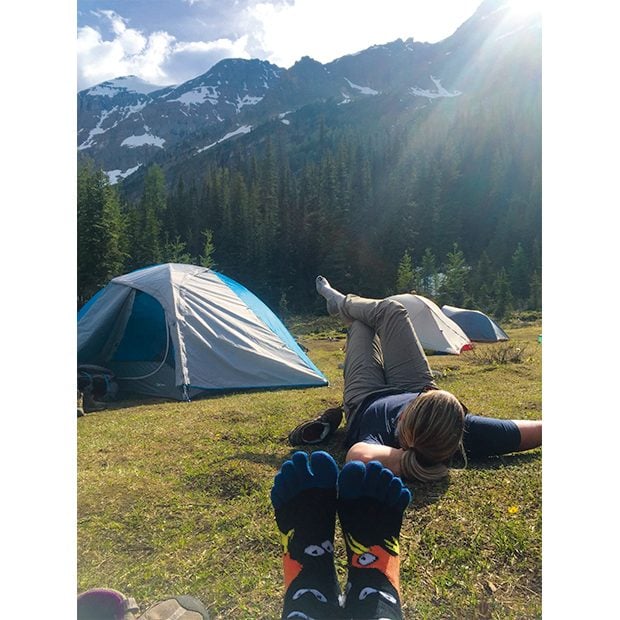
On the third day, our group did a 12-kilometre hike to two peaks called the Niblet and the Nub. This was by far the highlight of the trip. The weather was perfect and the view was breathtaking. We stopped for lunch on the Niblet with Mount Assiniboine in the background, surrounded by Lake Magog, with Elizabeth, Sunburst and Cerulean Lakes about 1,000 feet below.
There is also a lodge along with some cabins on the mountain, so if you don’t want to rough it you can stay there instead. There is not a lot of room in the campground; we were bumped into the overflow camping area and even that was packed. Either way, you need to plan and book ahead!

A Canada Day to Remember
Being the long weekend, the lodge was serving cake. On Canada Day, we wandered over to the lodge hoping for a piece, but sadly by the time we got there, they had run out. We decided to celebrate with a few glasses of wine and beer instead—not a bad way to end the day!
You would think that having nine women who were strangers meet up and plan a trip that required them to spend five days together might be a mistake, but, as things turned out, we all got along great. I believe the love of the great outdoors we all share created an immediate bond and connection. I made new friends and had the experience of a lifetime!
If this Mount Assiniboine hike has you lacing up your boots, be sure to check out our countdown of Canada’s best hiking trails.
“I’d like a Relaxed Fit,” I type in an Instagram message to my potential drug dealer. It’s the code for her high-dose CBD cookies. (The THC-forward ones are called High Rise, get it? They’re both jeans, but those ones are high.) They’re $55 for a dozen, but she only has ginger with turmeric (blech!) available at the moment. I give up and log on to cbd2go.ca, load my cart with two tinctures and a pain salve and then begin watching my mailbox for the package that’s promising me sweet, sweet relief.
I’m not the only one waiting for the mail—CBD2GO’s website has constant pop-ups informing me that, in the past 10 hours, someone in Stouffville or Brampton or some other Canadian town purchased a 1,000-milligram Calyx Heal or coconut tincture. It’s like they’re shouting, “You! Law-abiding middle-aged mom—you are not alone! All these Extremely Average Humans have heard the promises of this magical elixir called CBD, and they, like the poster on Fox Mulder’s wall on The X-Files, want to believe.”
And I do. I do want to believe. I’m one of the many average humans who, along with not-so-average scientists, doctors and investors around the world, are currently obsessed with the possibilities that CBD—short for cannabidiol, one of at least 480 components of the cannabis plant—is dangling before our eyes. CBD isn’t intoxicating, unlike THC (a.k.a. tetrahydrocannabinol), the better-known cannabis derivative stoners have been buying from “a guy” for years.
It’s also a potent anti-inflammatory, and its advocates say this potential miracle medicine can help treat everything from pain, anxiety and sleep disorders to arthritis and even schizophrenia. The U.S. National Institutes of Health took out a patent on certain cannabinoids in 2003, and in 2018 the U.S. Food and Drug Administration approved a CBD-derived drug for the treatment of particular types of epilepsy (a similar medication underwent a promising clinical trial in Canada in 2019). In the U.S., depending on what state you’re in, you can buy a dizzying array of CBD-infused products, including luxury skin care, teas, makeup, beverages and lube.
Canada legalized the use and sale of certain kinds of recreational cannabis—flower, oils, seeds and plants—in 2018. The next wave of legalization, which covers edibles, extracts and topicals, happened in fall 2019. Ever since the weed door opened, the biggest buzz has been around CBD. This makes sense given the potential size of the market—your neighbour might not smoke a joint in the rec room with you, but she definitely has sore knees and would like to try some of that “special” balm you told her about. People have always found ways to get high, but can CBD make us well?

Life without pain
Deena Gandin certainly thinks so. After years of pain caused by her house cleaning job—and two car accidents within 10 months in 2018—the 48-year-old from Binbrook, Ontario, was ready to try anything.
“I’m the most skeptical person on the planet,” she says. “But I didn’t want to be on narcotics. I finally just said, ‘The heck with it,’ and tried CBD.” She used a CBD oil. “It was life changing. I was like, ‘Oh my gosh, is this what it’s like to not live in pain?!’ I used to come home at four and barely be able to make it to the couch. Now I can keep going until nine. I’ve told everybody—I’m ready to shout it out from the mountaintops.”
Gandin also noticed another interesting change when she started taking CBD—her lifelong depression and anxiety subsided. “I don’t have that horrible feeling of worry in my stomach anymore,” she says.
How can one molecule affect so many things? And if CBD does, in fact, help treat all the conditions researchers think it might, how does it know where to go in the body? “There are scientists all over the world trying to figure that out,” laughs Danielle Blair, the founder of Calyx Wellness, a Canadian company that produces CBD products. “Our body just knows exactly where it needs to be.”
Part of the answer probably has to do with our endocannabinoid system (ECS). The ECS, which was only discovered by medical researchers in the 1990s, is a network of cannabinoid transmitters and receptors that helps maintain the body’s homeostasis, or balance. Our bodies naturally produce cannabinoids on their own, and there are receptors for them all over the place—including in the brain, heart, pancreas, nerve cells, skin, reproductive organs, digestive system and liver—that influence things like our immune response and levels of inflammation, appetite and pain.
Cannabinoids are also produced in cannabis plants—these are called phytocannabinoids. When phytocannabinoids meet human body cannabinoid receptors, it’s like an affair that was always meant to happen.
Dr. Richa Love is one of the more outspoken proponents of CBD. She’s the founder of CannU Educational Services, an online cannabis education platform. “Think of the receptors as locks,” she explains, “and think of cannabinoids as the keys.” (That’s the gist of the ECS, though CBD doesn’t technically go into the locks—it just activates them, prompting the body to produce even more of its own cannabinoids.)
Love has been a family doctor for almost 20 years. About five years ago, she turned down an elderly patient who asked for a medical cannabis prescription to help relieve arthritis pain. “All my training and all my instincts were to think of it as drug-seeking behaviour,” Love says. “So she went to another source, and then I saw how her arthritis got significantly better. That was a humbling moment as a physician.”
Love suffers from rheumatoid arthritis herself. About four years ago she had a flare-up that was so bad she was in constant pain, on multiple medications and walking with a cane. Her rheumatologist even suggested maybe it was time to pause—or end—her career. “I tried CBD oil, and it transformed me,” Love says. “So I started to look at it more seriously.”

My first try
My personal interest in CBD stems from a long struggle with insomnia and more recent issues with chronic pain. Since I hit my 40s, I’ve been constantly straining or tearing things, resulting in a daily Advil-plus-Tylenol (then maybe some more Advil, topped off with a splash of Aleve) habit, which is likely wreaking havoc on my liver and kidneys. I’ve also taken benzodiazepines for sleep on and off for almost 15 years, lately more on than off, putting me at a higher risk for developing a dependence and, eventually, dementia. Massage, osteopathy, surgery, acupuncture, cognitive behavioural therapy and meditation—among other things—haven’t totally fixed either issue.
“Mommy can’t play with you right now,” I tell my eight-year-old. “Mommy’s arm hurts. Mommy is tired.”
“You’re always tired,” he sighs.
I need to find another way. And then my other way arrives in my mailbox.
I try a small array of CBD-infused products—chosen by the extremely unscientific method of how much I like their websites—to deal with my chicken-egg situation (my insomnia exacerbates my pain, but my pain keeps me from sleeping). A salve from a company called Organa doesn’t provide relief to my arm, where I’m still healing from a tendon- and ligament-repair surgery, or my leg, where my doctors think I’m experiencing referred pain from a torn tendon in my ankle—perhaps a tall order for a $35 product. I take 30 milligrams of CBD oil capsules from a company called CoCos Pure for a couple weeks, to little effect.
I’m starting to lose hope. Then I turn to the priciest option in my new arsenal: Calyx’s Heal tincture, which costs $140 for a 30-millilitre bottle of 1,000-milligram-strength CBD oil. “Heal is intended to treat more serious health conditions,” CBD2GO promises, without naming any specific ailments. “It delivers a larger dose to the mind and body to kick-start the healing process.”
“Whatever,” I think, popping open the top. “It’s all probably snake oil.” I start taking the oil—holding it under my tongue for 30 seconds and then swallowing it—with my daily vitamins and supplements. It’s, you know, oily, but otherwise inoffensive. I misread the instructions and end up ingesting more than the maximum recommended dose of 45 drops a day—about 60, divided into two full droppers throughout the evening—for about two weeks. This amounts to approximately 68 milligrams of CBD a day, more than double what I had tried before. (Thankfully it’s very hard to overdose on CBD: unlike opiate receptors, none of the cannabinoid receptors are located in the part of the brain stem that controls your breathing and heart. Also, because CBD research is still in its relative infancy, there isn’t a standard for what’s an appropriate dose.)
And guess what? I think it starts to work. It’s not like popping a Percocet or a sleeping pill—where you get an instant, obvious result—but I notice I’m taking fewer pain and sleeping meds, I’m sleeping better, and I’m more chill and less grumpy, even when I’m overtired.
It could be the placebo effect, but I feel it helps enough that I decide to try to get a medical prescription for cannabis so my insurance will help with the cost. Manulife and Sun Life both cover it. To my great surprise, both my family doctor and a pain specialist turn me down immediately, saying there isn’t enough evidence that it treats insomnia or chronic pain.
How could this be? I call Love again. It turns out they’re right—sort of. There is lots of evidence demonstrating CBD’s efficacy for managing pain, but it’s all from observational studies or animal studies. There have been almost no double-blind, placebo-control trials.
“The amount of enthusiasm people have for these products at the moment far exceeds our understanding of them,” says Dr. Michael Allan, the director of program and practice support at the College of Family Physicians of Canada and the lead author on a set of simplified guidelines for cannabinoid use.
The guidelines recommend medical cannabinoid use as a last resort for a small subset of conditions, including neuropathic and end-of-life pain, and chemotherapy-induced nausea. The guidelines don’t differentiate between products that are high in CBD and those that are high in THC. The research that’s available, says Allan, is focused on THC and is obtained mostly from people who are already using cannabis, which creates a huge bias. “It’s guesswork at this point,” he says. “The limited studies seem to indicate a combination of inhaled THC and CBD is needed for pain. CBD on its own seems to have no benefits.”
Love won’t give up on the promise of CBD. “It isn’t a chemical model that can be replicated the same way over and over in a lab,” she says. “CBD is plant-based medicine—it’s a square peg that’s not going to fit in the round hole we’ve created for pharma. Also, there are hundreds of different types available on the Canadian market. Which ones are you going to study?”
Love puts doctors’ reluctance to prescribe it down to a combination of a lack of education when it comes to the rapidly evolving field—since the endocannabinoid system wasn’t discovered until the 1990s, a lot of doctors didn’t learn about it in medical school, and even now it’s often not on the curriculum—and, worse, a hesitation born out of a lingering discomfort around any kind of cannabis use.
CBD may be just the beginning of the useful compounds found in cannabis—the properties and uses of the dozens of others it contains are only starting to be understood. (If you haven’t heard about cannabigerol or cannabinol yet, you probably will soon, but that’s a story for another day.)
Despite the unknowns, there’s one story I’ve heard from every CBD expert I’ve spoken to, and it goes like this: In a time that’s not so far away, taking CBD will be as common as popping a multivitamin or supplement.
“It will become an absolutely normal thing,” predicts Blair. “You’ll wake up and take your CBD and your fish oil. It’s the best anti-inflammatory in plant medicine and so many diseases stem from chronic inflammation. People will say, ‘Of course I take CBD.’”
2019, Leah Rumack. From “CBD Is Touted As A Miracle Compound, But Does It Actually Work? We Tried it,” Chatelaine (December 2019).
Next, find out if blue light glasses really work.



